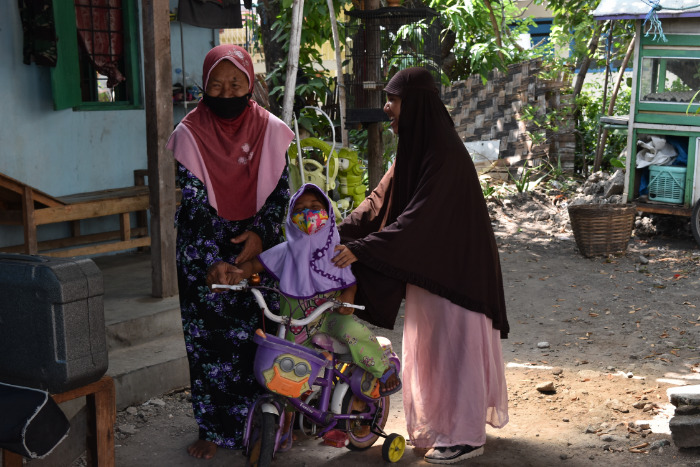Disability, inclusion and cities: can COVID-19 trigger change?

Susiana, her mother and daughter in a low-income neighbourhood in Indonesia. As Susiana is visually impaired and her mother is an older woman, they have been following strict health protocols and staying at home during the pandemic. Interviews conducted as part of COVID research. Photo by: Kota Kita
Disabled people living in informal settlements have been not only affected by the general consequences of the pandemic, including decreasing support from carers, family and friends and difficulty accessing basic supplies, but also by the threat of increased stigma and exclusion.
However, some community organisations have mobilised: providing life-saving resources, accessible information, new spaces for participation and innovative collaborations. In doing so, they have also mapped strategies for inclusive urban development.
Taking a local look at disability
While we know that 15% of the world's population lives with a disability, there is no global data specifically on informal settlements.
An indication of scale can perhaps be gleaned from the WHO Rapid Assistive Technology Assessment conducted in 2019 as part of our research project, Community-led solutions: Assistive Technologies in Informal Settlements, led by The Bartlett Developing Planning Unit and Global Disability Hub.
The assessment surveyed 4,000 people across four settlements in Banjarmasin, Indonesia and Freetown, Sierra Leone. It was carried out by our partners, Indonesian NGOs Kaki Kota, Kota Kita and the Federation of the Urban and Rural Poor (FEDURP) and Sierra Leone Urban Research Centre (SLURC).
We found that 26% of people surveyed experienced at least ‘some difficulty’ in seeing, walking, hearing, remembering and/or communicating. One third lacked the assistive products they needed.
In April-August this year, the project expanded to include a response to COVID-19. Kaki Kota and FEDURP took the lead, providing support and conducting interviews with disabled people in informal settlements to understand the impact of the pandemic.
Disproportionate impacts
We found that disabled people often saw the impacts of COVID-19 as similar for disabled and non-disabled residents, such as loss of income and poorer access to basic supplies.
However, distinct effects on people with disabilities also emerged, including:
- Loss of livelihoods: Many disabled people depend on begging or practice trades which are greatly affected by social distancing (for example, masseurs with visually impairments in Indonesia). Lower income decreases access to food and water.
- Reduced educational opportunities: In Indonesia, parents of disabled children have found it difficult to adapt to online teaching, having to modify learning materials and cope without sign language support.
- Unequal access to government support: In Sierra Leone, only recognised disabled groups received support, overlooking many residents of informal settlements. In Indonesia, the bureaucracy around government cash transfers has been a barrier for many disabled people.
- Limited social life and capacity to organise: In Indonesia, social distancing has seen activities for disabled people cancelled; many cannot afford internet access to join online alternatives. Risk of infection has also limited the chances for disabled people’s organisations (DPOs) to meet or provide in-person support.
- Poor access to information: In Indonesia, signage about social distancing is not accessible for people with a visual impairment, causing even more difficulties for using public space.
COVID-19 response narratives emphasising the importance of ‘healthy bodies’ exacerbate these difficulties and increase stigma towards disabled people. Social distancing rules have limited offers of help from the public, such as support crossing the street.
Local leadership reaches the right people
Community-based support is vital in a pandemic, to manage information and resources and control the outbreak. However, we found that disabled people tend to have less contact with community leaders, lower levels of participation and limited use of communal spaces, meaning they are liable to miss out.
A targeted approach is needed, and community organisations are well-placed act: FEDURP and Kaki Kota delivered water, food parcels and face masks (transparent masks for sign language users) to people with disabilities in low-income communities.
Both organisations built accessible sanitation points and distributed coronavirus information in a range of formats; Kota Kita’s accessible support guide met the disabled community’s demand for better information on COVID-19
After COVID-19: inclusive urban development?
As urban development organisations – rather than disability specialists – FEDURP and Kaki Kota could situate action on disability within wider initiatives. This ensured that disabled people can access mainstream community resources, as well as raising awareness of their needs across sectors.
As locally embedded organisations, Kaki Kota and FEDURP could make quick decisions and corroborate community-level data. Kaki Kota shared georeferenced disability data with city authorities, enabling support to reach disabled people. They also formed a disability-focused consortium of community-led organisations and NGOs, supported by the Government of Banjarmasin.
The community-led responses discussed here show how local organisations can play a vital part in knowledge production about disability in informal settlements, not least by engaging with DPOs and disabled people directly as research collaborators. They also show how community organisations can scale up inclusive interventions by collaborating with other organisations and authorities.
There is a real opportunity for this thinking to transcend the current crisis and place disability at the centre of an inclusive approach to development, both for and with disabled people.
This blog post was originally published on the IIED website on 1st October 2020. The authors wish to acknowledge the valuable support from the IIED team for this piece.